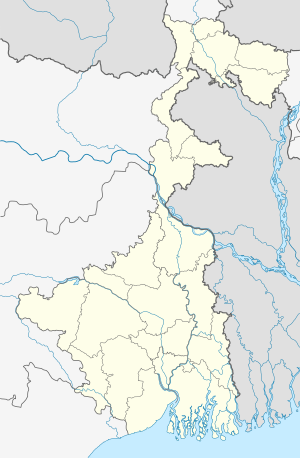Nungi
Nungi is a neighbourhood in the Maheshtala of the South 24 Parganas district in the Indian state of West Bengal. It is a part of the area covered by the Kolkata Metropolitan Development Authority (KMDA).[3]
Nungi | |
|---|---|
Neighbourhood | |
 Nungi Location in West Bengal  Nungi Location in India | |
| Coordinates: 22.4973°N 88.2214°E | |
| Country | |
| State | West Bengal |
| Division | Presidency |
| District | South 24 Parganas |
| Region | Greater Kolkata |
| Government | |
| • Type | Municipality |
| • Body | Maheshtala Municipality |
| Elevation | 9 m (30 ft) |
| Languages | |
| • Official | Bengali[1][2] |
| • Additional official | English[1] |
| Time zone | UTC+5:30 (IST) |
| PIN | 700140 |
| Telephone code | +91 33 |
| Vehicle registration | WB-19 to WB-22, WB-95 to WB-99 |
| Lok Sabha constituency | Diamond Harbour |
| Vidhan Sabha constituency | Maheshtala |
| Website | www |
Geography
 |
| Cities and towns in the western part of Alipore Sadar subdivision (including Budge Budge I & II, Thakurpukur Maheshtala CD blocks) in South 24 Parganas district M: municipal city/ town, CT: census town, R: rural/ urban centre, Owing to space constraints in the small map, the actual locations in a larger map may vary slightly Bakrahat is in Bishnupur II CD block, but Lakshmibala Rural Hospital at Bakrahat serves Budge Budge II CD block and so it is included here. |
Area overview
Alipore Sadar subdivision is the most urbanized part of the South 24 Parganas district. 59.85% of the population lives in the urban areas and 40.15% lives in the rural areas. In the northern portion of the subdivision (shown in the map alongside) there are 21 census towns. The entire district is situated in the Ganges Delta and the subdivision, on the east bank of the Hooghly River, is an alluvial stretch, with industrial development.[4][5][6]
Note: The map alongside presents some of the notable locations in the subdivision. All places marked in the map are linked in the larger full screen map.
Location
Nungi is located at 22°29′50″N 88°13′17″E. It has an average elevation of 9 metres (30 ft).[7]
Economy
Located near the industrial locality of the Batanagar, shoe making is a common cottage industry in Nungi, with families manufacturing shoes for brands that have out-sourced labour, including Khadim's, SreeLeathers, and Liberty. Nungi once had a thriving fireworks industry and the "Chocolate Bomb" from Nungi market remains well known during the Diwali festival. In 2007 a joint development project was announced involving the London-based company REIT Asset Management, Eden Realty Ventures Private Limited, a Bengali NRI and the Mahestala Municipality. The project, known as the Maheshtala project, involved the development of a mini township near Nangi railway station.[8]
Transport
Nungi is on the Budge Budge Trunk Road.[9]
Nangi railway station is on the Sealdah–Budge Budge line of the Kolkata Suburban Railway system.[9][10]
Commuters
With the electrification of the railways, suburban traffic has grown tremendously since the 1960s. As of 2005-06, more than 1.7 million (17 lakhs) commuters use the Kolkata Suburban Railway system daily. After the partition of India, refugees from East Pakistan/ Bangladesh had a strong impact on the development of urban areas in the periphery of Kolkata. The new immigrants depended on Kolkata for their livelihood, thus increasing the number of commuters. Eastern Railway runs 1,272 EMU trains daily.[11]
Education
Nangi High School is a Bengali-medium school for boys. It was established in 1947 and has facilities for teaching from class V to class XII.[12]
Nangi Balika Bidyalay Up High School is a Bengali-medium school for girls. It was established in 1948 and has facilities for teaching from class V to class XII.[13]
References
- "Fact and Figures". Wb.gov.in. Retrieved 5 July 2019.
- "52nd REPORT OF THE COMMISSIONER FOR LINGUISTIC MINORITIES IN INDIA" (PDF). Nclm.nic.in. Ministry of Minority Affairs. p. 85. Archived from the original (PDF) on 25 May 2017. Retrieved 5 July 2019.
- "Base Map of Kolkata Metropolitan area". Kolkata Metropolitan Development Authority. Archived from the original on 28 September 2007. Retrieved 3 September 2007.
- "District Statistical Handbook 2014 South Twety-four Parganas". Table 2.1 , 2.2, 2.4b. Department of Statistics and Programme Implementation, Government of West Bengal. Archived from the original on 21 January 2019. Retrieved 5 December 2019.
- "Census of India 2011, West Bengal, District Census Handbook, South Twentyfour Parganas, Series – 20, Part XII-A, Village and Town Directory" (PDF). Page 13, Physiography. Directorate of Census Operations, West Bengal. Retrieved 5 December 2019.
- "District Human Development Report: South 24 Parganas". Chapter 9: Sundarbans and the Remote Islanders, p 290-311. Development & Planning Department, Government of West Bengal, 2009. Archived from the original on 5 October 2016. Retrieved 5 December 2019.
- Falling Rain Genomics, Inc - Nungi
- "London-NRI route to mini townships". The Statesman, 18 May 2007. Archived from the original on 29 September 2007. Retrieved 3 September 2007.
- Google maps
- "34112 Sealdah – Budge Budge Local". Time Table. India Rail Info. Retrieved 3 November 2019.
- Mondal, Bhaswati. "Commuting and Metropolitan Development of Kolkata". ResearchGate. Retrieved 29 December 2019.
- "Nangi High School". ICBSE. Retrieved 3 November 2019.
- "Nangi Balika Bidyalay Up High School". ICBSE. Retrieved 3 November 2019.
External links
